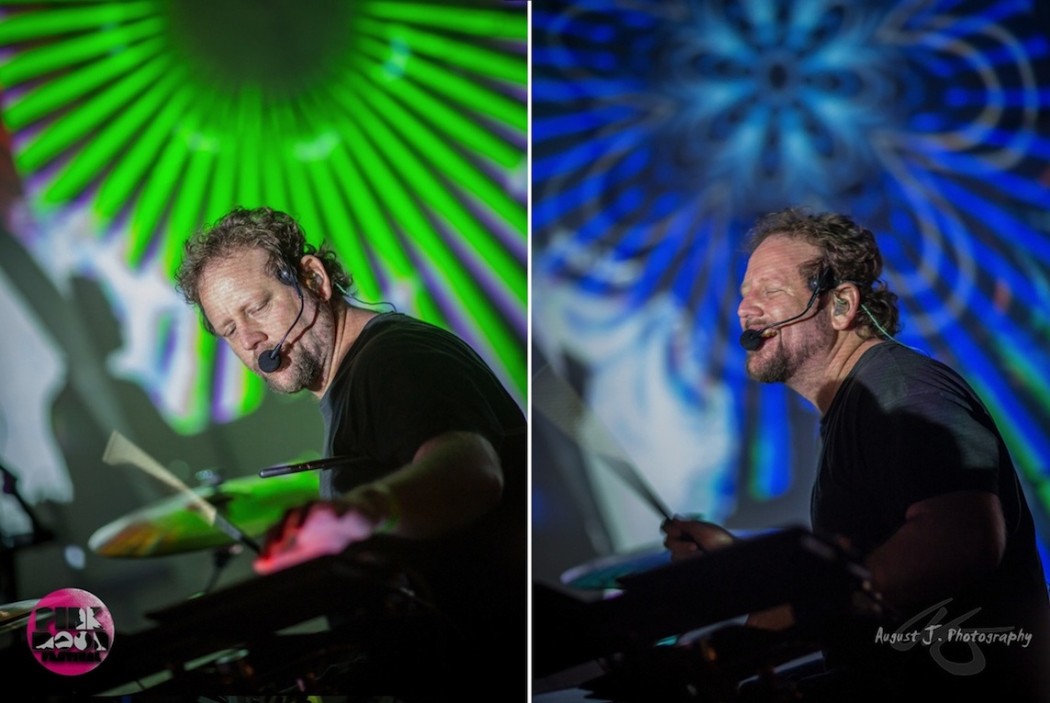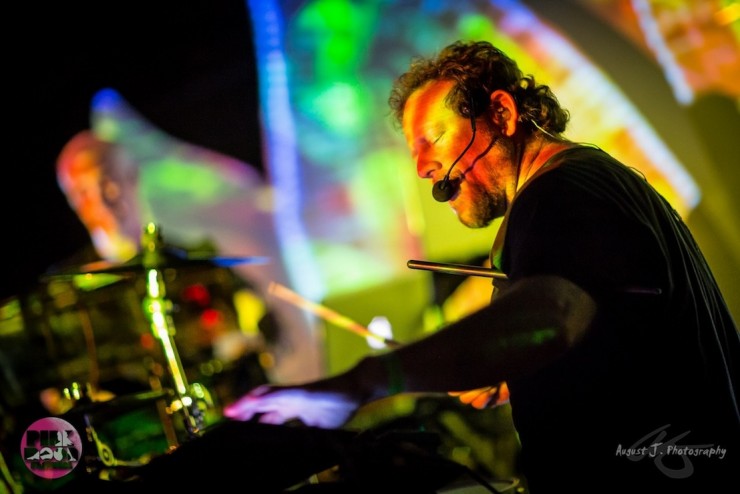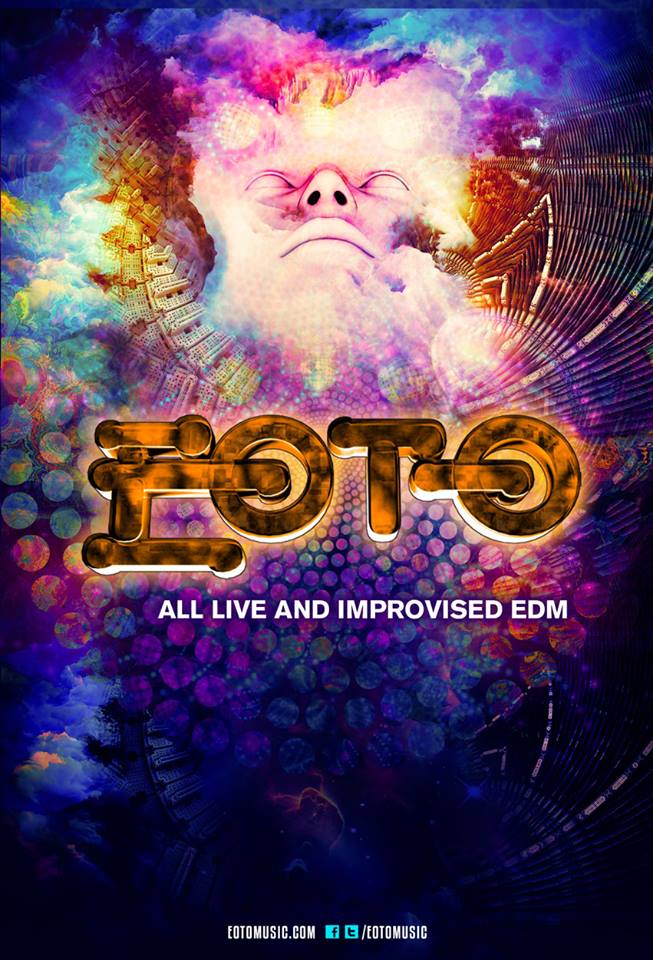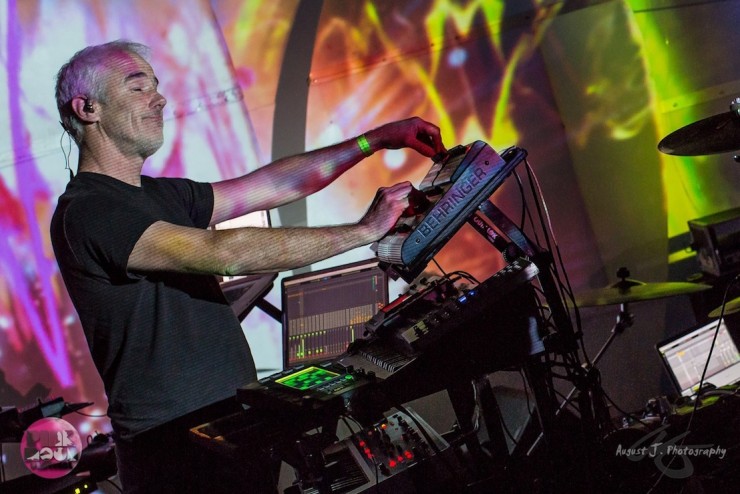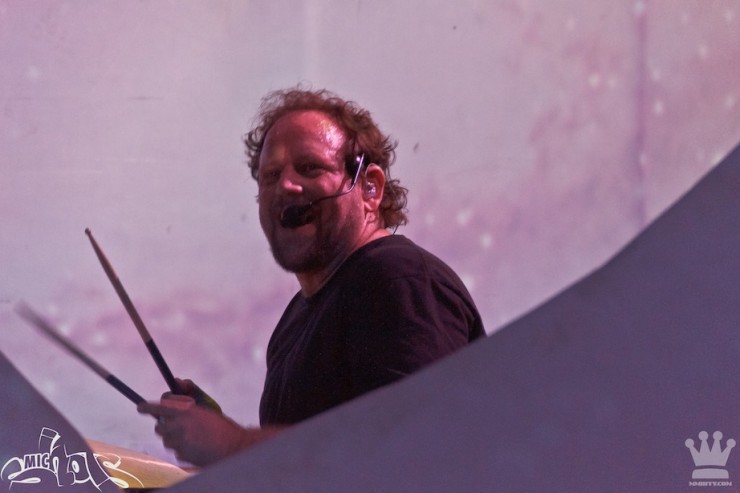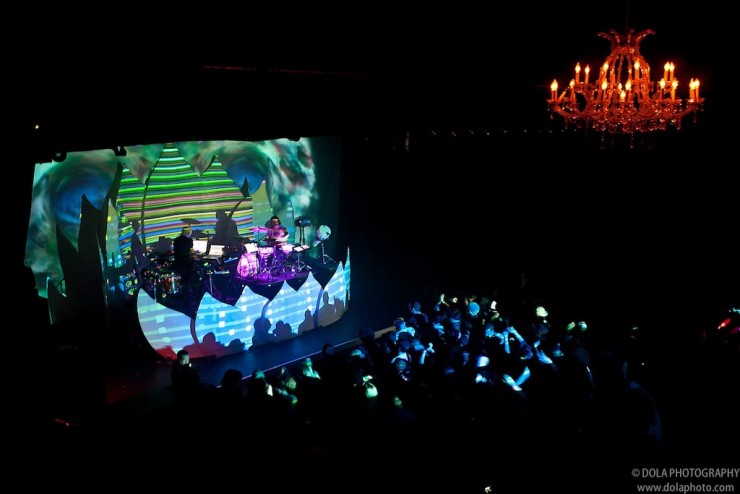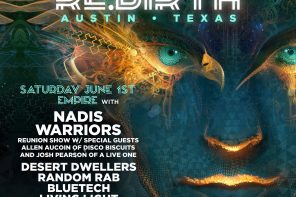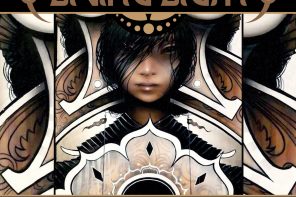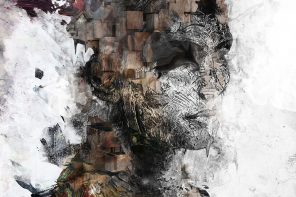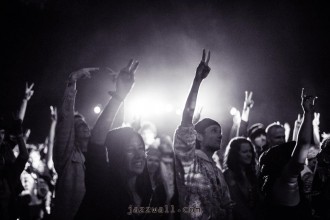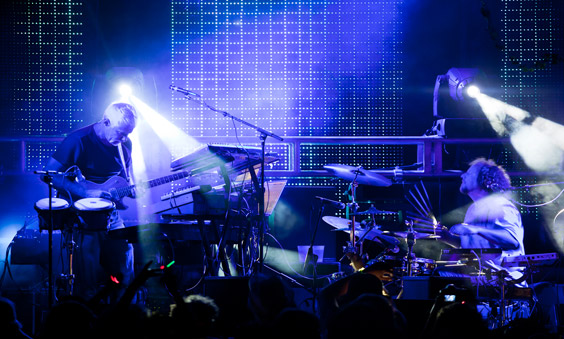 [LiS] We know the official kick off was 2006 Sonic Bloom. But EOTO germinated in a basement, for those just catching on, could you talk about that a little? What you originally were using Ableton Live for (Jason), and what led to you using it as a brain for your looping set-up?
[LiS] We know the official kick off was 2006 Sonic Bloom. But EOTO germinated in a basement, for those just catching on, could you talk about that a little? What you originally were using Ableton Live for (Jason), and what led to you using it as a brain for your looping set-up?
[Jason] Yeah 2006 was the first gig. We’d been jamming around, without any intention necessarily really of starting a group or putting an act together. That’s maybe one of the reasons it started coming together. We were just playing around, having a great time, playing with toys, playing with instruments, playing with electronic styles live… Just the two of us. This was probably around the time of Ableton. I had it really early on, and I had so much fun with that program. It was the only program I could really record live into in a way that I could use – instead of a looping pedal I would use Ableton on my own. I could just start stacking up percussion parts, you know, like stack 30 percussion parts and create this big tribal drum thing at home in my own studio. I would use it kind of as a hobby, I used it at a couple jazz gigs, I’d loop parts live.
So I was using it, but I didn’t think it would be the main vehicle for a group. Then Travis and I started playing around, and he started using a looping pedal and we wanted a more complete and controlled sort of setup, and I suggested using Ableton. It ended up working perfectly, and there’s still no other program that can do what it does. Ableton is just that up on being ahead of lesser software programs for recording live.
When you started the EOTO project did you have any anticipation of it taking off from being just a side project? Was it still even a side project in your eyes, by Sonic Bloom?
We didn’t know what it was going to be. We got to a point where when we would record what we did, we would get excited about it. I think Travis had communicated that to Jamie Janover, who’s in charge of Sonic Bloom Festival. Jamie was thinking of ways to get more kids out there for a Colorado festival and was interested in the idea of having two people from String Cheese with a new project come out and play and maybe that would attract more people to Sonic Bloom. So when we started doing that, we did that gig and we were like alright, this is good, it’s a pretty fun thing to do. And it was sort of out there within String Cheese Incident that we might be breaking up, and we were like well what are the two drummers of String Cheese gonna’ do for a career if we’re breaking up? We were like, well we did this thing and it was fun, so lets just book a ton of shows and see what happens… See if people like it, and go from there.
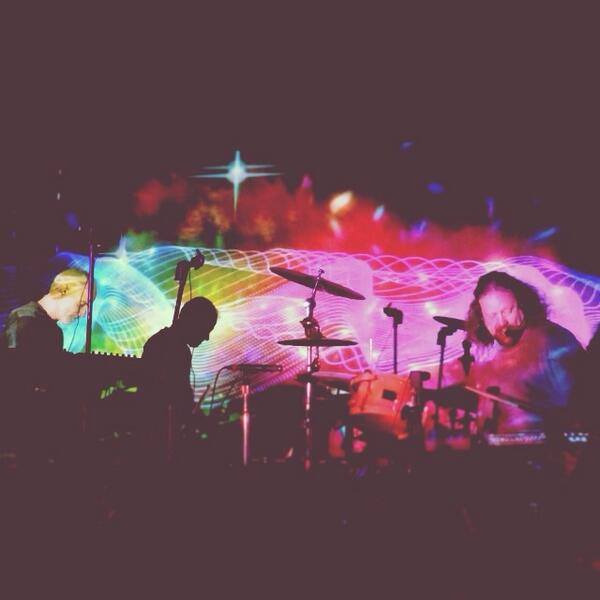
From Sonic Bloom ’06, to over 200 live shows in 2008 in 2 years including an appearance at Shambhala – what was that like?
Oh yeah that was just a thrill. For a while there we were just starting to do shows on our own. Like getting in a vehicle and touring. We’d get there on a Monday night and something like 40 people would show up. And we’d be really happy if even a 100 people showed up through the weekend. But we were such “road dogs” that we could hit almost every stage within the country within the year once if not two times because we were just in an RV equipped with all of our gear. We’d stay in hotels, and there weren’t any bands touring back then – almost no DJ’s were on tour. Our numbers started going up as we hit all the cities for awhile and it was really fun seeing it happen for an all improvised live band.
Usually improvised music you’re performing in a museum or a college auditorium for other college students studying music, or in a library or something like that.
And so that started building a lot of steam and that was definitely a big encouragement to keep it up and keep the schedule busy.
How did you get noticed by Shambhala Festival so quickly – what was it like for you as an artist at that point in life, and had you ever been/heard or known about it? Can you tell us a little bit about how you guys were influenced by your experience with dubstep aficionado Skream?
So it was a combination of experience – touring with String Cheese, knowing a lot of the bigger promoters and people that run festivals. They promote smaller shows in cities, like the guy who runs Wakarusa who was also throwing shows in Lawrence, Kansas. We played there a few times, and he was like how would you guys like to play at Wakarusa?, which was in Lawrence, Kansas at that time. That was our very first festival, and we’ve played Wakarusa ever since.
It feels like we’ve grown up with different festivals. And that kind of got our name out there, and that’s how some of these guys found out about us early. We were playing these festivals every year or every other year so that talent buyers would notice us, and by the time we got to play Shambhala it was an incredible highlight. Seeing Skream, that made such an impact and was huge to us because that was probably our first laser bass show and our first real witness of an aggressive approach to dubstep. Because before dubstep used to be the most mellow music and was super downtempo chill, you know go lay down and listen. So seeing Skream do that first aggressive dubstep drop, and 3,000 people lose their marbles and be like OH MY GOD was just madness, plus the fact that this kind of music wouldn’t hit the States for another 2 years, man it was crazy.
Yeah in terms of rhythm dubstep used to be more laid back reggae dub
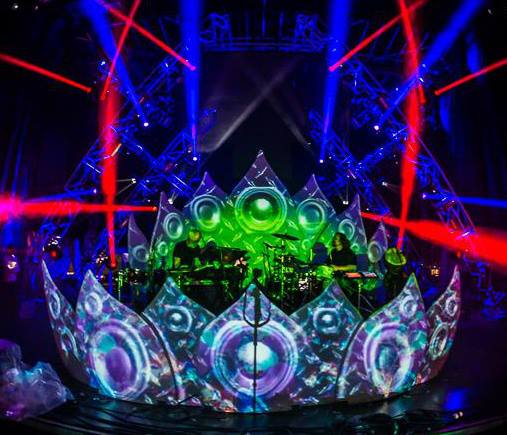
Yeah it was a lot closer to reggae dub than the metal style head banging, body grinding, you know it’s just eraser drill bits and stuff like that. So in that way it kind of took on the same evolution as drum ‘n’ bass. Drum ‘n’ bass used to be more like jungle with dark mellow murky bass sounds and then it got harder and harder until it was drum ‘n’ bass which then became a competition to see who could make the most intricate fast beat to almost drill bit bass sound the best. Dubstep kind of did the same thing as far as that evolution in such a short period of time. But yeah seeing Skream that year at Shambhala swiveled our heads around. The following year Excision kind of ruined that stage for everyone else after that weekend because it was like someone had taken it to the point where the whole entire set was gonna be transformers and lasers and machine guns in a cinematic way. Shortly after that he began to come down to the states.
He laid it down that hard?
Oh yeah. So it was like where Skream had one moment that leveled the whole place – Excision’s entire set was like that, and he was just a kid, some Canadian dude who lived in the surrounding area near Shambhala. I don’t even know how much touring he’d done but he killed it and on the same stage as Bassnectar. I think he had like a ten o’clock slot on a Friday, and after that the whole weekend it was like that set was good but, oh my god did you catch that set?
That must have been a true experience there.
Yeah and that must have been like 2009… We played that year too on one of the stages, but when you’re there it’s like wow if I want to listen to one of the best sound systems on the planet, then I’ve got to get to the village stage and hang out there all weekend!
And had you seen anything like that before?
It was more like I hadn’t heard anything like that before. I had seen a lot of sound systems, huge ones with a lot of subs, but this one was immaculate/the champion of all that. I think there were nine subs, it was so ridiculous. The bass just wrapped itself around you and didn’t make your eardrums hurt.
How do you feel about your work in EOTO in comparison to your work in String Cheese Incident? Does one influence the other? Do you prefer one over the other for certain aspects?
I think there are some cross influences. And I definitely don’t feel like one is better or worse than the other, just different experiences entirely. I try to play the best that I can every night for each situation. As far as the way things get influenced, I think EOTO has become a thing on its own. There was a while there when we were first starting and some hardcore String Cheese fans really hated EOTO and still do. Because you know, “there’s a computer on stage,” and we’re not “playing the same instruments we do in String Cheese,” and the music is “so different,” and “what’s that sound, it sounds like noise” – there’s some of that. So there was this degree to where we had to get our own audience. And that influenced String Cheese somewhat. It’s hard to say. Like the fact that some of the guys in the band were open to the idea of adding or even suggesting that there’s some electronic stuff because they can see there’s a younger generation coming up that’s all about it.
As far as electronic music goes, Kang and Travis had been going to Burning Man since the 90’s and were friends with Lorin (Bassnectar), and they were the ones that exposed him. When Bassnectar was just “DJ Lorin,” he opened up for String Cheese before I joined the band (in 2004). I wasn’t there for that, but I do remember in 2005 on Jam Cruise that they had never had a DJ on Jam Cruise before. So one of the things they were doing for the super late night in this tiny little disco room on the boat that could hold 100 people was billing “Michael Kang Featuring DJ Lorin” with Kang playing violin, while Lorin was dropping his tracks. At that set there was maybe maaaaaybe 30 people up there, and I was one of ‘em. That was 2005 so it’s really amazing to see how far things have gone. So that was history right there even before I was in String Cheese, there was that influence in electronic music culture because Kang wanted to bring this alternative music culture that he was witnessing at Burning Man that was made up and coming from a DJ standpoint and having this percolate in the String Cheese community a little bit.
How much of the variation in your sets occurs because of your personal state of mind – your mood, what kind of music you’ve been listening to, what you ate for breakfast – and how much of it comes from the vibe you get from the crowd?
Haha, I wonder. I never really think about it in those terms. But sometimes I really like my power naps – if the night before was rough and I didn’t get a chance to really sleep that day, then I might nap a couple hours before we go on and sometimes I might wake up five minutes before a show. But I won’t need coffee or anything to wake up, I’ll be ready to go right away. So there’s a certain degree to where my mind is in a seminal state and might do something different. But for the most part I like being completely sober during the show. I might have a drink or two, but my favorite feeling really is the moment of seeing where the bar is set every night. I feel like I have a good judgement and approach it in a way that continues from the night before which feels really good because I can really tell when I’m repeating something I’ve done. Or if there’s something that I’d really like to do and then practice it and try to do it on stage. So that’s one good reason why I really like to be sober during a show.
When I’m sober and I hear recordings of us, I remember that moment and exactly what I was going for. In that regard it makes me feel like I’m going into the next night with a lot more confidence of what I can change or what I can do better.
All bands go through stylistic phases. Can you talk about the musical path that EOTO has gone through since its inception and try to break down what led to the style changes?
When we were fresh out of the gate, breakbeat music was still really cool, and our biggest influences were people like Bassnectar, Tipper, and this guy Bill Bless who used to go by the name S.O.T.E.G.. Then we were off and listening to Sound Tribe, Lotus, and this group Siamese out of Seattle with KJ Sawka on drums… They never got really big but there are recordings out there of their shows that are really killer. Then this band from the U.K. which had members from Massive Attack, and those were the only all improv acts that I know of. They were super influential because they were making up stuff and making it sound “wow,” a really well produced performance. So at that time it was more breakbeats, some drum ‘n’ bass, and some downtempo things. We had such different gear back then – it was much more of a minimal setup. I think Travis had his guitar, one bass, and one MicroKorg synthesizer because he wasn’t trying to emphasize his key playing yet. I had a drum-set, an electronic drum-pad that had a lot more sound, and I wasn’t singing yet.
Earlier on, Travis kept collecting keyboards and trying different ones out. Then we had a show out in Breckenridge, Colorado, and our tech guy forgot my drum sampler. I needed this thing so much to stack the drum grooves I was playing currently. I was pretty bummed about it, so I started doing vocal percussion with my mouth and looping things. People started reacting to that and being like what was that, that was cool. Little by little I’d start putting in made up words. People would be like you’re playing it like an alien (in a really percussive way). That lead to singing and making up more alien like words, quoting songs. So it was always kinda’ like a remix, whatever was going on and whatever style we were playing. So we’d be playing downtempo breakbeat, drum ‘n’ bass, a little bit of house… And then when we hit Shambhala, we heard all the dubstep stuff and Travis would try to recreate some of those sounds with the keyboard. I would emulate the beats, and that was just kind of like our own little journey. We saw a lot before anyone else was doing it. We got more addicted to that as that year went on. We started selling more of our sets and just trying to be gnarly at doing that. In the last two and a half years, we’ve been trying to incorporate more of the styles we used to. Like playing house a little more and bringing out the glitch-hop more as well.
Getting more funky with it.
Yeah! Being a little more funky with it, and the stuff we were doing really early on, I guess jazz was a big influence. But now with the glitch-hop thing with Opiuo and VibeSquaD, and others getting bigger, we were like “oh that sounds like fun too.” Now things in the last year have really come full circle – we’re gonna hit the gnarly dubstep, but we’re gonna go through a whole journey with the house, some techno, drum ‘n’ bass, some 70’s funk style stuff, chill with some glitch-hop. Now we’ve even figured out how to do trap as well by gating the kick drum. So Travis can be using a synthesizer with a sine wave on it, but it doesn’t make any sound until my kick-drum hits. When my kick-drum hits, it triggers the sound that he has dialed in (which is usually a straight sine wave). My kick-drum sounds like an 808, but it can change notes too depending on how Travis is playing it. And that’s been pretty fun from a technical standpoint because there’s been no band really able to pull it off.
That’s pretty insane to be honest.
Yeah, well it still feels great that we’re doing it live. Because the only way I’ve really seen other bands pull this kind of thing off is by having pre-recorded tracks. And we love that challenge of figuring out how to do this stuff, and it’s just like boom! Let’s do it!
Some fans have expressed that in your recent tours, you have been appealing to the trends in the EDM scene by being more heavy with the dubstep and trap style. How would you respond to that?
Well I guess to a degree, we definitely want to be really up on music. But if anything we started doing dubstep in 2008, we just weren’t popular then. We’d be playing in front of like 100-200 people before, and no one could put names on what we were doing, but we were doing it because no one had ever heard of this kind of music before. So to many the music seemed purely improvised… And we were pretty much way ahead of things in terms of people doing a two person set up, and it was after Derek of Pretty Lights saw our setup that he started bringing in a drummer to do his thing. He was using Corey for a while and then Adam Deitch to have a setup with a drummer and a producer kind of thing. It’s not exactly what we did, but it helped popularize a setup that we had already done back in 2006.
When trap first came out, we were hearing it at smaller festivals, and we thought “oh this is a new thing that’s coming out, but ya’ know it’s not really out there yet.” We just wanted to figure it out because we had to figure it out. So it seems like we are following trends, but it’s mostly because a lot of people just haven’t heard it because they haven’t seen us play yet or weren’t following us all along that much. But we have all our stuff archived, so you can hear what we were doing early on. We definitely pride ourselves on being able to play all of the different styles that are out there (though we’re not necessarily following behind it). We’re not necessarily still doing acid jazz, even though that’s still groovy to listen to. It’s just not always what people are getting off on, so when we go back and do it again sometimes people are like “oh man, what’s that new thing they had going?” Even though it’s not new at all (haha).

Jason, could you answer questions on Travis’ setup?
A little bit, yeah.
Could you summarize what kind of scheme he is using for the Behringer B-Control Rotary BCR2000 controllers? Curious as to why he needs two of them – that’s a lot of knobs.
Yeah, that’s a lot of knobs. Well let’s see, the way he’s got things assigned, he can record up to ten tracks. That’s just how he’s got his Ableton setup for what he does. So you figure, I think those Behringers have eight faders on each of them. I think his is all knobs and buttons though – it’s set up as a mixing board with eight on there. He needs at least ten of those though to fill out the controls for his Ableton template with the ten tracks, so he can record and manipulate each track individually. So there are a couple knobs assigned to each of those would be tracks. Since there are only two up top, he has a lot of knobs on the other Behringer controller to be able to use a bunch of auxiliary effects and turn other things on and off.
I’m not sure if he’s completely using both of them. I know they have the ability to use a page button and flip through pages of different controls. But when we’re live on stage, you don’t want to be flipping through pages or virtual pages. It’s too confusing so if it’s all laid out right in front of you, it might mean shlepping around more gear, but it makes the creative process a lot easier when you don’t have to think about “is it this page or is that the right page that I’m on with these controls?” That’s the thing for my zone, I probably use about four iPads now. That’s probably about 150 buttons and knobs I program onto all 4 of those things.
Wow, okay that’s a lot.
Yeah, and I could probably put it all on one iPad and have a bunch of pages, but it would probably just hinder the process when we’re trying to do and create all this stuff live.
Yeah, it’s better in that scenario to be able to fully utilize your range of motion.
Yeah, exactly.
Gotcha’, and for the gear nerds that is a “Behringer Rotary BCR 2000.”
Yup, it’s all rotaries.
The TC Helicon Voice Synth Pedal – this seems to be integral to your voice looping. As someone who uses Ableton, did you experiment with the vocoder and vocal processing options available? What made you go with a hardware pedal, or do you still do some of your voice effects within Ableton?
Well I stopped using the hardware pedal, and now I use “Antares Harmonizer” plugin. Now my voice can be harmonized which is one of the evolutions of my setup, where I’m trying to go away from the hardware and have it all in the computer because I can manipulate it a lot more, and there’s less to bring around.
I personally like going for a less and lighter setup, because firstly it’s less things breaking and also it’s less things to keep track of.
And also really being able to manipulate beyond a certain point to where if I was just using hardware, there might be a limitation control wise or something I’m restricted to. Like with hardware I might be able to set it up in a midi kind of way, I might be able to execute it in a timely way, depending on the beats per minute we’re playing at, but it’s way better if that hardware end is already wrapped up inside the computer. It’s one less piece of hardware, one less power supply wire. I tend to be able to find the things I need to use in the computer that work great. Or as good or better than some hardware that’s out there. I love hardware though. If I had to use hardware to replace all these effects I’m using in Ableton that would be… It would just be too much to bring around. It would look cool but…
Your shows might get a bit more expensive.
Yeah, exactly (haha). It’s great that all my controls are on my iPad, so it’s in my backpack, it’s on me. Only if I fall on it on top of ’em is something gonna’ happen. But when all your stuff is being put through luggage in airports, it’s just getting thrown around. Travis has had a broken knob or something gets pulled out and damaged en route just because the probability is higher.
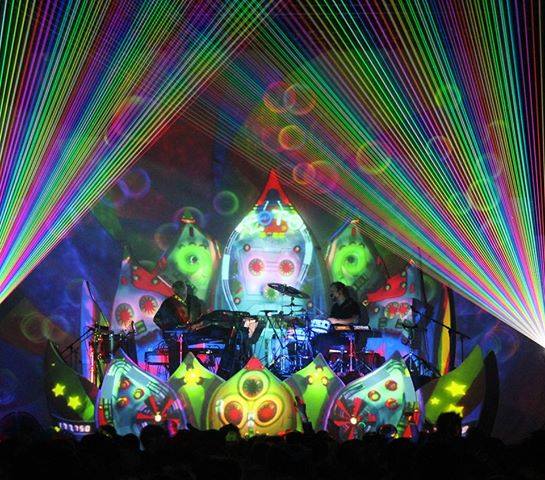
So you just have your mic routed into your Motu UltraLite-MK3, correct? Do you just do all your voice controls with the iPads then?
Yup, I do all my vocal effects from the iPads with the Jazz Mutant “Lemur” application. Then there’s this app “OSC Touch” and between those two programs, I can cover whatever I want on Ableton, and like I said there’s probably about 150 things that I have assigned. I just love being able to reach over into my space station and be creative about what I want to turn on and off.
Do you still use the JazzMutant controller?
That thing, no I don’t. After about 400 shows, the thing finally fell in New York, and I turned it in to get fixed. But at that same show, it was like well, I guess I’m gonna’ have to use the app they made for the iPad. Then they stopped making the JazzMutant controller, because it was a really advanced touchscreen and then I think they got bought out by Hewlett Packard to work on their touch screens. So now I think there’s not even anyone around to fix those JazzMutant Lemurs. But I’ve got two of ’em!
So even though you got more that work, it’s easier to use the iPads.
Yeah and the Lemur would need a special cushy bag. I would always be worried about it when transporting it.
I’m aware you use a Motu UltraLite-MK3 and Motu traveller model, as well as a Firewire mixer as the input sources for all your instrument lines. However the circuit-diagram you’ve released (on the EOTO wiki) gets a little tricky, I follow most of it. Does the venue just get their input from Travis’ Motu Traveller and your UltraLite, or do they get everything from the Firewire mixer? Anyway you could clear that up, for aspiring live performers?
Oh sure, we send two lines, a stereo left and right (the same way a DJ would) to the venue. So we’re doing the mixing ourselves up on stage. The reason there’s a Firewire mixer, that’s in Travis’ world, I think that’s what he plugs his guitar and bass into. He has another computer on stage running synths from Propellerhead’s “Reason” and the outputs from the sound card of that computer are also running into that mixer I believe. So before he gets it all into computer world, all his stuff goes through that Firewire mixer. Then his Firewire mixers outputs go to the Motu Traveller on his side. Then on my side, my outputs of my Motu UltraLite-MK3 go over to the inputs of that same lead Motu Traveller over in Travis’ world. So his stuff all routes to the lead Motu Traveller as well as my stuff, and then it all gets mixed down in computer-world, and then a left and right stereo pair get sent to the front of house.
So to clear that all up, the venue just gets one stereo pair line from the lead Motu Traveller in your chain between you two?
Absolutely, Yes! Nice, good summary!
Now with all of your instruments, are you plugged strictly into your UltraLite, or? I thought the Motu Traveller on your side of the stage in the diagram was only for recording the show.
I see now that’s a good question. So yes I have an UltraLite in my zone. And what we use to record, we’ve probably changed it up since that diagram. What do we use, we don’t use Motu to record the show anymore. I can’t think of it off the top of my head, but it’s just a thing that we can carry around that allows us to record two track recordings, but it goes in through USB to the recording computer, and we take two lines from the lead Motu Traveller. And it has it’s own mix because it’s hooked into the recording in the computer. So in my world, I have my instruments hooked into my UltraLite, that’s what my vocals are routed into.
Oh, I have my own monitor from my iPads, where I have a keyboard hooked up to my iPad, and I can play notes into it but it just helps me with my pitch. Like when I’m singing, If Travis is playing a groove on the keyboard, and changing his keys and doesn’t tell me where he’s at, it helps me match the key he’s playing in because I’m the only one who can hear it. It helps me tell what key he’s in, and I match him and go from there. What else is going into that Motu UltraLite… My djembe goes through the UltraLite as well, and then my second little snare, all my other drums go through the lead main Motu Traveller.
Oh so the main drums of your kit go straight to the lead traveller?
Yup, exactly.
So the second part to that question, you already kinda’ answered. Do you guys premix all of your the levels in your Ableton template yourself?
Yup, well, we mix all of our levels ourselves. It’s not necessarily a pre-mix that we go through, because that changes all the time depending on the sounds that are involved. With our version of a sound check on my side, all the drum stuff tends to stay the same. Not too much has to be adjusted and the same with Travis’ world, things stay relatively the same. But sometimes things change. One sound might be a little louder than the other especially when we are bringing in new parts. When I’m using a drum-rack in Ableton, I’ll have to go through each one of those sounds on the drum rack so it can really jump out and I can make sure it’s not gonna be too quiet or whatever. But if I do that early on, then I usually don’t have to worry about that by the time I use it at a show.
Now for the instrument lines and the stuff you don’t change much at all – do you do all the mixing in Ableton, or do you use the mixing software built into the Motu interfaces?
All in Ableton.
With more transformational festivals on the rise, and stuff like Bluetech’s project “Nomad Culture,” what do you think and how does it make you feel as/how are you influenced as artists to look at the vehicle you’ve created as a musician as being something to empower, to educate, or to bring together other people on a conscious level?
Nice question. So what I think we do, I think there’s a little bit of playing by example, hmmm. Where we are completely winging it when we are on stage… So in that sense it’s a form of transformation, of constant transformation where we aren’t even trying hard to go somewhere, and it’s just constantly being completely in the moment. And that can be either a good or bad example, depending on the situation and where you are because you don’t know where it’s gonna’ go. You don’t know what’s gonna’ happen. You might be the kind of person where you need things to be well thought out and you want to meditate on distance to take things from here to there. So we just do it our own way. And we’re transforming minute by minute, and definitely night by night.
After a month of tour goes by, we’ve become this different thing. So the process of being an improvised band is constantly letting go and letting go. Not being so attached to the idea that there’s only one way to do things, and you can use that as a metaphor for how you go through life. If you have a bunch of things where you feel like you’re doing the same thing over and over, and you’re in a complete rut, well what can you do to take yourself to the next level? Or is that your safe zone to do the same thing day after day, is that more comfortable?
We choose to be constantly evolving and changing and never want to repeat ourselves so that ensures that the only thing we can do is move forward, ourselves and our opinion of what’s going on onstage.
So would you say the way you express yourself and communicate with music is a spiritual process or tool for your own growth?
Well, yeah. But spiritual growth is very individualized. If you talk to Travis, that’s where he gets pretty much all his inspiration for anything he’s doing musically is the fact that it’s a very constant spiritual journey. And I tend to feel like that part of it is a given. That that’s just a full part of my intention when playing is to keep evolving that. I don’t necessarily know where it’s gonna’ go. I don’t have a place where it has to go or it doesn’t have to go, but just that it goes. And that it’s a constant sense of discovery without an end game to it. There’s no place or time with something I’ll be doing with it where I’ll be like “I’ve Arrived!” or “I’m there” or “I’m spiritually aware.” It’s more like “oh lets discover this, now lets discover this, now lets go here.” So everyone has their own process of what they are getting at from what they’re doing. And I definitely feel that. I go back and forth from being onstage and being like THIS IS FUN, and just letting it be fun and groovy or between like I just wanna’ harness this emotional thing and dive deep into the way I’m pounding this rhythm out and stuff and see it reflected in the way people are moving in front of me. And I really wanna’ push myself to this, and I don’t know what’s going to happen but I’ll figure it out when I get there.
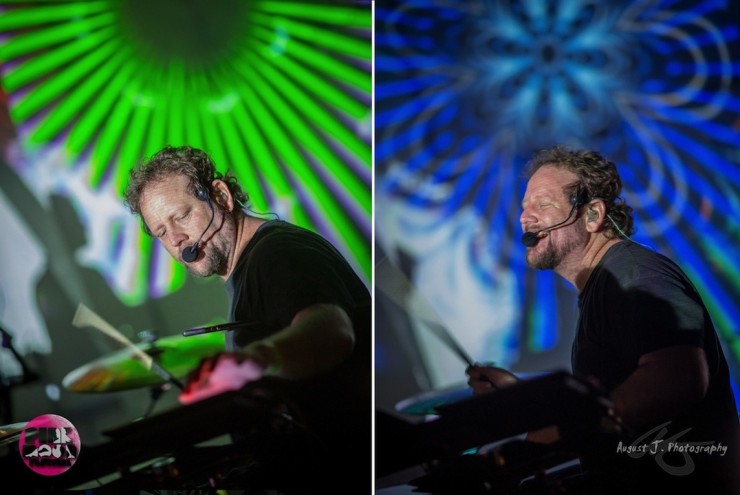 So it’s a constant cyclic process of learning what you love, and exploration.
So it’s a constant cyclic process of learning what you love, and exploration.
Yeah absolutely, there’s no one way to do it. People have their own way, and that’s part of what makes everyone their lovely selves. People try to define it, and people try to tell other people how you should do it or shouldn’t do it. But everyone has their own unique, beautiful journey. And at least if you can recognize that it is a journey and that it’s not a limitation – it’s not an end goal. That it’s something that feels like it takes you to another level of awareness, or whatever you’re wanting to even chase after if it’s something. Then you do it your own way and express it your own way.
Jason it’s been beautiful and inspiring talking to you. Thanks for participating in this interview, everyone reading this, you can catch EOTO on tour at a festival near you this summer!
Thanks man, right on and thank you for doing this. I’m glad you asked a lot of really great questions which made it fun for me to hide out in this room from everyone else, put myself in my own place, and answer as best I could.
We appreciate you hiding out to take some time for us, thanks again. Happy touring!

